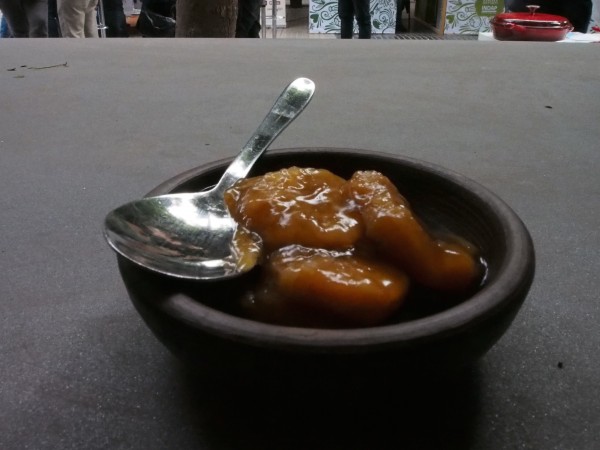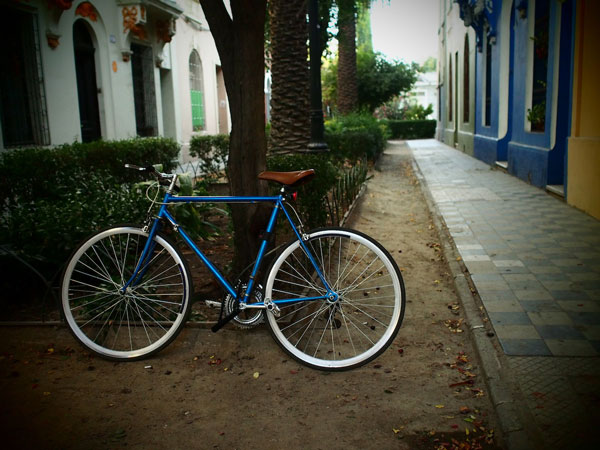Every rainy day in winter, Chileans coo, “que rico,” and head to the closest supermarket, casino (cafeteria) or grandmother’s house to get their sopaipillas pasadas on. Sopaipillas, which you might know from other Latin American cuisines, are round disks of dough, deep fried. In Chile, sometimes they are enriched with squash, though not always. They are a teen and college-aged treat late at night on street corners, eaten with a sweet mustard, and ají, a spicy sauce.
But on rainy days, visions of different sopaipillas, the hand-patted ones, slightly irregular, certainly squash-enriched, and smothered in a sweet syrup dance in Chileans’ heads. And I am left to chalk this up to nostalgia. Nostalgia for a food eaten as a child, for warm kitchens and special treats and your hair dripping down your back even while someone hands you a hot mug of tea and you know that you are warm, and that somebody loves you.
But sopaipillas pasadas don’t mean that to me.
And here’s where I admit something that could even cause problems for me later on, if ever apply for Chilean citizenship (mostly kidding about the troubles, my main challenge will be the national anthem). Until the day before yesterday, I had never eaten sopaipillas pasadas. I was convinced by a friend once to try picarones pasados, which are similar, but more ring-shaped. The sauce that makes them pasadas, made of chancaca, a dark brown brick of sugar that in this case is dissolved in water, and boiled with orange peels, cloves and maybe cinnamon, is not to my liking. It’s thick and syrupy, and I like my fried things crisp, not sodden. What’s the point of all that oil if it just collapses back onto itself, I thought?
In the time since then, I have written about sopaipillas pasadas on more than one occasion, even developing a recipe for them, but suggesting that they be dipped in, rather than soaked in the syrup, but that is a personal preference, and I have been told by several Chileans, is just plain wrong. I was at a talk by Pebre, a group that promotes homestyle Chilean cooking at a recent event at Ñam, and the cooks were basically crowdsourcing, asking Chileans what was special about the Chilean table. And you could almost feel a ripple of nostalgia. No one puts down as many salads as we do, no one dresses their salad with lemon, no one serves the kind of bread we do. All this over the smell of carbonada cooking, a kind of brothy soup made with stew meat, layered over the Chilean sofrito, this with peppers and onions and ají de color (paprika), and cumin seed, parts of a type of Chilean garam masala, if you will, which we call aliño completo (complete seasoning), which contains only these things, oregano and garlic, as if you would never need anything else.
And I got to thinking again, about a longstanding pet project of mine, talking to people about food nostalgia. Because the things you eat aren’t just what they taste like, they are what they remind you of, of the context in which you first (or last) ate them. They are my Chilean friend in Montreal biting into a completo (Chilean hot dog, with avocado, mayonnaise, tomatoes, ketchup and mustard), and drinking a cup of hot tea, closing her eyes for just a second, and I know, even sitting across the table that this completo has hit the spot. They are a friend holding a camping cup full of tea after a long hike that has deposited us beside a waterfall in complete darkness, and saying, “Que reconfortante,” (how soothing). It doesn’t matter what is in her hands, or in his cup. What matters is that there is this enveloping sensation that settles down like a warm blanket, that says, “you are home.”
But like the Tren de Los Recuerdos, which I joked was the train of other people’s memories, this dish, sopaipillas pasadas, was not designed for me. As part of Ñam, there was catering, and they made very tiny sopaipillas and doused them with the aforementioned sauce, and set them out on a table, and everyone first asked what it was, because the sopaipillas were so small, and the format could also have been mote con huesillo ( a drink which I actually do like, and have even created my own nostalgia for).
I took a dish and went outside, to try my ridiculously delayed bite of sopaipillas pasadas. I had to fight a little, as the sopaipillas were not entirely soaked through, and when I finally took a bite, I sort of got it. There’s still a little crunchy layered flakiness to the sopaipilla, a spiced warmth to the goopy syrup. I tried to receive the nostalgia of the hundred or so people around me, all eating the same food. But it was not raining, and there was nary a grandmother to be found, or at least not mine.
So what I got instead of that community nostalgia was, tastes like chinese noodles in duck sauce.
But not to Chileans it doesn’t. To the ones who love sopaipillas pasadas it tastes like rain and winter and comfort.
I could sit and lament my lack of connection with the sopaipilla pasada lovers, how I’ll never understand Chile, never get the nostalgia of the food, despite living here for so long. Or I could, like I generally do, surround myself with like-minded people, including Chilean friends who, upon hearing this story, said things like “the world is divided between those who like sopaipillas pasadas and those who like them plain. Luckily, the latter are the majority,” and my favorite of all comments, which sounds better in Spanish, so I’ll type it in the original first, “me cargan las sopaipillas pasadas.” (I can’t stand sopaipillas pasadas). Makes me wonder as a sub-sub project, what other nostalgic foods are out there that have a upstream contingent that can’t stand them, either.
Possible future project: finding Chileans who don’t like marraquetas (the semi-official national bread, similar to French bread rolls).
PD (PS), Ñam has a market of products from all over Chile as well as food trucks on Friday, Saturday and Sunday (April 17-19, 2015), on Cerro Santa Lucía, enter from Alameda. I can’t speak to the quality of the food trucks, but the market has been interesting in past years, and the people selling goods quite willing to chat. Starts at noon.











great post! we shared it on our facebook page (inside santiago) because we felt so identified! =)
I just saw that, thanks. I hope no one comes to my house and steals my maple syrup because of it. Worst comment ever by a Chilean after tasting maple syrup, “Sabe a caramelo,” tastes like “caramelo,” an artificially-flavored syrup sold in the supermarket. GAH!
Caramelo (en español) es lo que se obtiene al calentar a altas temperaturas los azúcares, ya sean del azúcar misma, o de otros orígenes, como la miel, el jengibre, el regaliz, la leche… incluso la cebolla…
Obviamente, el más famoso es el que se obtiene del azúcar (seguramente el que recordaba tu amiga), pero hay otras recetas, que lo mezclan con agua y azúcares de distintos orígenes para darles distintas consistencias y formas, líquidas, sólidas…
Todos aquellos que tu conociste en tu infancias como “candies” en español se llaman caramelos…, por haber sido hechos de esta manera (obviamente agregándoles colorantes, edulcurantes, aromatizantes, preservantes, etc…)
About the project to “find chileans who don`t like marraquetas”… I do not think that you can possibly find one! Just consider that dear Marraquetas have become a higly appreciated gift that – as concealed as precious smuggled diamonds- travel from Chile to the dear friend who lives in another country! Often asked for, despite the trouble that may face carrying them across borders, almost every travelling out chilean tries to smuggle “marraquetas”! …And get away with it.
Pisco is another good gift asked for but, since it`s “bottled” it`s permited, so it lacks the “drama”.
hahah, thanks for commenting Marcela. I know you’re right! And actually that is helpful for a piece I’m writing. I think nearly all foreigners love marraquetas, too!
Well…they ARE delicious!
Mmmmmm food… Reading this made me taste all of those again in my memories
you’re the perfect person to talk to me about Chilean nostalgic foods. I tasted carbonada while I was at the fair, despite the meat (I am trying to be a “flexitarian,” ha! I think I’d have to be Chilean to get that, too! BTW, looking into a July trip to Temuco/conguillío (it’s with a photographer). Will let you know if I’m coming close!
I am not a super-fan of sopaipillas pasadas. I eat them once every 3 years or so…
In my imagination, sopaipillas pasadas are not just “pasadas por chancaca”, but also the leftovers from the day before (‘pasadas’, as ‘viejas’). Then it makes sense (to me) to turn them into a different dish.
Oh, and chancaca is a brick of sugar… and molasses! That’s the colour!!
but people make them fresh to sink them in the syrup! Everyone I know that eats old sopaipillas toasts them on the toaster. I’m still not a fan. I know all about chancaca, but I don’t really care for the syrup it makes, though I have made it myself for certain recipes. Not anymore though, now I have arrope de chañar and algarrobina and molasses in the house. YUM!
May I just say I completely understand, and I love this idea for a pet project. I also love this writing sharing and then will go get my nostalgia comfort food:hot chocolate with grilled cheese.
see, and I don’t have that as nostalgia, though it does sound yummy, and perfect for a cold, rainy day!
I’m 100% Chilean and I totally HATE sopaipillas pasadas ! Or picarones pasados or anything pasado. And I hate squash too. But a good, cruchy squashless sopaipilla with ají or chancho en piedra (or even plain)… THAT is heaven! *sighs*
I used to hate squash, and especially how they served it in my house as a kid (with butter and brown sugar), but butternut squash made it all possible for me. And yes to anything with pebre, or ají or chancho en piedra! It seems there are more of us than I might have guessed!
He, he,he ! I think you are contending with a …quite invencible enemy: the warm memory of “that” what meant “Home”.
The “Chúcara” ( Wild , untameable) “style of be” of this long and narrow land… I think confronts you with a quite ample field to explore!
He! I would love to know your experience with “empanadas de pino”! Baked in “Horno de barro”! ( A clay dome, about the size of a “city car”, heathed by which ever is at hand capable to get in fire for at least the time enough to get the appropiate temperataure required to bake bread”.
My bests, Marce.
I don’t eat meat, so I’m not the ideal target audience, but Chileans do have a way with masitas (though I prefer savory over sweet). Thanks for commenting, Marcela!